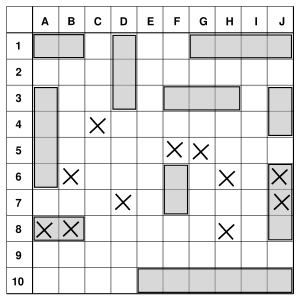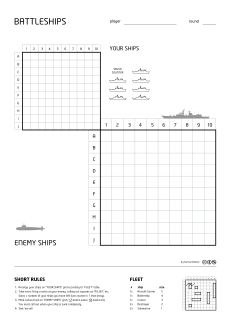Battleship (game) facts for kids
Battleship (also called Battleships or Sea Battle) is a fun strategy and guessing game for two players. It's played on special grids, usually on paper or a board. Each player has a secret fleet of ships. The goal of the game is to find and "sink" all of your opponent's ships before they sink yours!
Battleship started as a pencil and paper game during World War I. Companies began selling it as a pad-and-pencil game in the 1930s. Later, in 1967, the Milton Bradley company released it as a plastic board game. Since then, Battleship has become popular worldwide. You can now find it as electronic games, video games, and even a movie.
Contents
How to Play Battleship
The game uses four grids, two for each player. These grids are usually square, often 10 squares by 10 squares. Each square has a letter and a number to identify it, like "A5" or "G7".
Setting Up Your Ships
Before the game starts, each player secretly places their ships on one of their grids. This grid is your "ocean" or "primary" grid. Ships must be placed either horizontally or vertically. They cannot overlap, meaning only one ship can be on a square. Each ship takes up a certain number of squares, depending on its type.
Here are the ships usually included in the game:
| Ship Name | Size (squares) |
|---|---|
| Carrier | 5 |
| Battleship | 4 |
| Cruiser | 3 |
| Submarine | 3 |
| Destroyer | 2 |
Sometimes, the "Cruiser" is called a "Destroyer" and takes 3 squares. A "Patrol Boat" might also be used, taking 2 squares.
Taking Your Shots
Once all ships are placed, the game begins! Players take turns "firing" at a square on their opponent's grid. To do this, you call out a square's location, like "B3!"
Your opponent then tells you if your shot was a "hit" or a "miss".
- If it's a hit, it means you hit one of their ships! They mark this on their "ocean" grid. You mark it on your "tracking" grid (the other grid you have) to remember where you hit.
- If it's a miss, you didn't hit anything. Your opponent marks this on their grid, and you mark it on your tracking grid.
Sinking Ships and Winning
When all the squares of a ship have been hit, the ship's owner must announce that it has been sunk. For example, they might say, "You sunk my Battleship!"
The game continues until one player has no ships left. If all of your ships are sunk, your opponent wins the game! If both players sink all ships in the same round, it's a draw.
Different Ways to Play
There are a few fun ways to change up the game:
Salvo Style
In some versions, like the 1931 Salvo edition, players can shoot at more than one square at a time. For example, you might get to shoot at five squares in one turn. The number of shots you get might change as your ships get sunk. Your opponent might tell you the result of each shot, or just say "two hits and three misses" and let you figure out which squares were hit. The modern Milton Bradley rules suggest Salvo for more experienced players.
Other Fun Rules
- Some players like to keep it a secret when a ship is sunk. This means you have to keep shooting at an area to be sure it's clear!
- Another rule lets a player move one of their ships to a new spot every few turns. This makes the game more unpredictable.
- You can even play with more than two players or use ships with different shapes!
- In the United Kingdom, a popular variant includes 5 mines. These mines take up one square each. If you hit an opponent's mine, it "explodes" and destroys anything in that square and the 8 squares around it on your own tracking grid!
Images for kids
See also
 In Spanish: Batalla naval (juego) para niños
In Spanish: Batalla naval (juego) para niños




